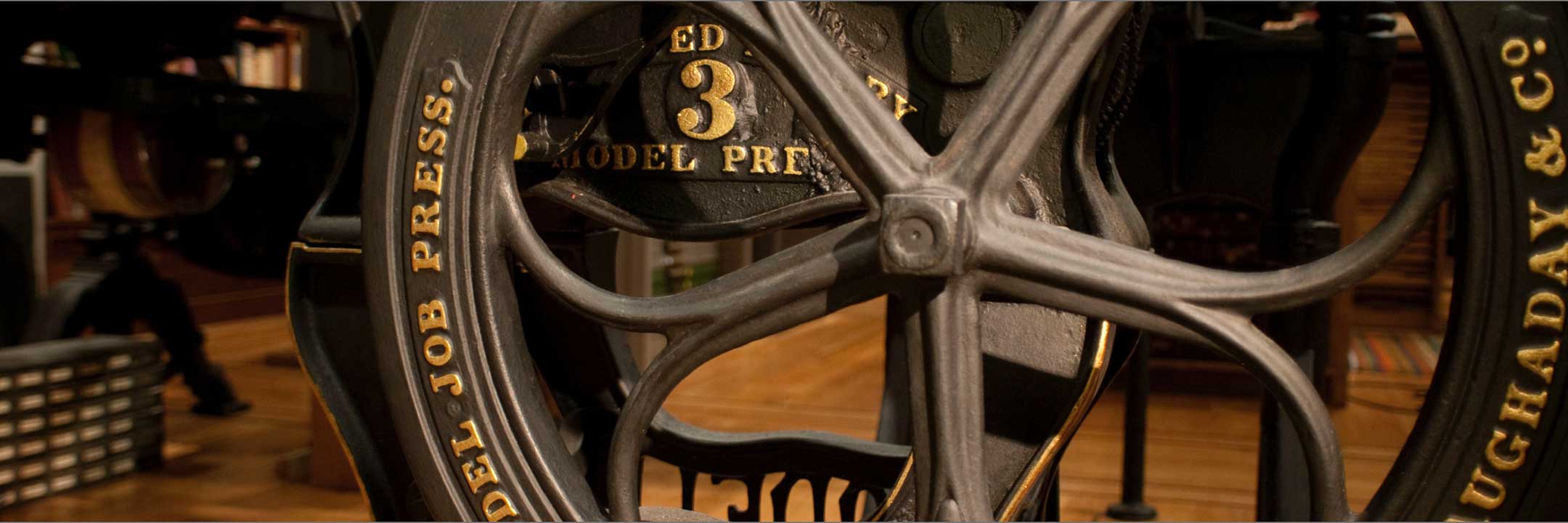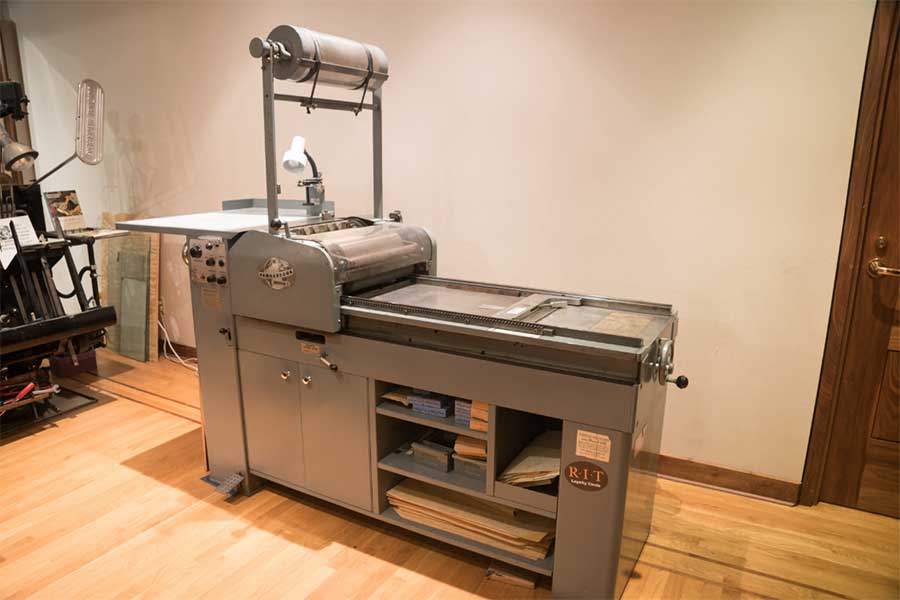Technology Collection
The Cary Technology Collection focuses on preserving the heritage of letterpress printing.
We preserve these objects through their active use in a variety of educational activities including classes and workshops. Scholars and artists-in-residence have joined college and elementary students alike in creating printed editions using this Cary equipment.
For inquiries and to schedule class and/or research visits, contact Amelia Hugill-Fontanel.

Printing Presses in the Cary Technology Collection
Handpresses
These types of presses are the some of oldest and newest in the Cary Collection. The iron handpresses were designed in the 19th century to improve upon the earliest models of printing presses that were made of wood. The use of iron allowed the presses to have larger beds (or printing areas). These presses were used to print book pages, newspapers, posters, and art reproductions. Pulling a lever activates the printing action.

- Acorn-style press, Cincinnati Typefoundry, Ohio, ca. 1825; From the collection of Wesley B. Tanner
- Albion press, London, England, ca. 1830s; From the collection of John DePol
- Albion press, England, ca. 1830s; Previously owned by Frederic W. Goudy and John DePol.
- Columbian press, J. M. Powell, London, England, 1876; Gift of John Jacobson, Sr.
- Kelmscott-Goudy Albion press, Hopkinson and Cope, London, England, 1891
This press has the most illustrious provenance of any of our presses. Selected proprietors include: William Morris (1834–1896), Frederic W. Goudy (1865–1947), Melbert B. Cary, Jr. (1892–1941), J. Ben Lieberman (1915–1984).
- Washington press, A. B. Taylor & Co., New York, ca. 1880
- Washington press, manufactured in America, ca. 1880
- The Uncommon Press, reconstruction of an English Common Press c. 1770–90, designed and constructed by RIT Engineering students, Rochester, New York, 2016
Platen Presses
Platen presses were an improvement upon iron flatbed handpresses because the inking became semi-automated with the addition of soft form rollers. Inking and the paper feed were eventually mechanized with steam or electric power, allowing faster print speeds. Jobbers, as they were also called, were commonly used to produce leaflets, calling cards, and small booklets. Tabletop models became popular for hobbyists. Rotating a flywheel or pulling a lever engages the printing action.

- No. 3 Model Job press by Daughaday, Philadelphia, mid-1800s
- Merritt Galley’s Universal Press, manufactured in America, ca. 1860; Gift of William Andrews
- Original Heidelberg (Windmill), Heidelberger Druckmaschinen, Germany, ca. 1956; Previously housed in the RIT School of Printing
- Golding tabletop jobber; Gift of the Rochester Carmelite Monastery
- Ideal No. 3, ca. 1880s; Gift of David Norton
- Curtis & Mitchell Columbian No. 2; Gift of an SPM alumnus
- Model 1 Improved, J. W. Daughaday, Philadelphia, Pennsylvania, ca. 1874
- Hohner tabletop press, Germany, ca. 1950; Gift of Paul Aken
- Craftsmen Press, Craftsmen Machinery Company, Boston, Massachusetts, ca. 1950; Gift of David Norton
- 21st Century Aluminum table top press, designed and constructed by RIT Engineering students, Rochester, New York, 2015
Cylinder Presses
Cylinder presses were originally developed simply for proofing letterpress plates and composed forms before the final print run on a larger press. The cylinder presses in the Cary were not designed to be production presses, but now students, artists, and printmakers employ them because of their versatility and ease of use. The printing action happens when a cylinder carries paper and the printing impression across the flat inked bed of type.

- Poco Proof Press, Hacker Manufacturing, Chicago, Illinois, ca. 1930; Gift of David Norton
- Challenge Proof Press, Challenge Machinery Co., Michigan, ca. 1945; Gift of William Andrews
- Vandercook No. I, R.O. Vandercook & Sons, Chicago, Illinois, ca. 1950; Previously housed in the RIT School of Printing
- Vandercook Universal I, R.O. Vandercook & Sons, Chicago, 1958; Previously housed in the RIT School of Printing
- Vandercook Simple Precision 20 (SP-20), Made by R.O. Vandercook & Sons, Chicago, ca. 1961; Previously housed in the RIT School of Printing